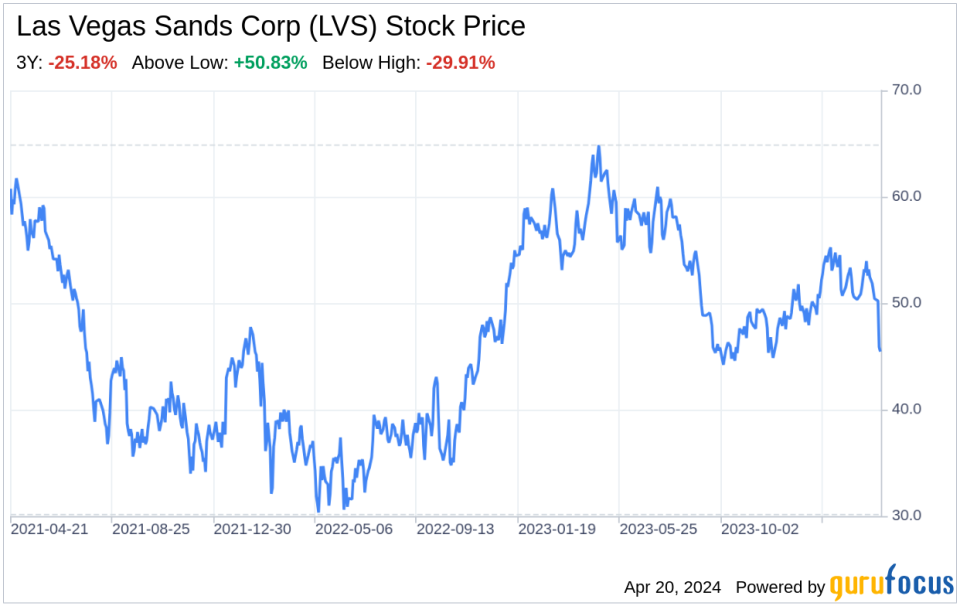
-
Las Vegas Sands Corp (NYSE:LVS) showcases robust revenue growth with net revenues increasing from $2.12 billion to $2.96 billion year-over-year.
-
Operating income has nearly doubled, signaling strong operational efficiency and market recovery post-pandemic.
-
Net income attributable to LVS surged to $494 million, reflecting a solid financial position and investor confidence.
-
Strategic developments in Asia and divestment from the U.S. market position LVS for focused growth in high-potential regions.
On April 19, 2024, Las Vegas Sands Corp (NYSE:LVS), the world’s preeminent operator of integrated resorts, disclosed its financial performance through the 10-Q filing. The company, renowned for its iconic properties in Asia, has demonstrated a remarkable financial turnaround, with net revenues climbing to $2.96 billion in the first quarter of 2024, up from $2.12 billion in the same period last year. This financial resurgence is underpinned by a substantial increase in operating income, which has soared from $378 million to $717 million. Net income attributable to LVS also witnessed a significant boost, reaching $494 million, compared to $147 million in the prior year. These figures underscore LVS’s financial robustness and its successful strategic pivot towards the Asian market, particularly after divesting its Las Vegas assets in 2022. The company’s focus on Asia, where it generates all its EBITDA, positions it uniquely in the casino and resort industry, leveraging the region’s growth potential.

Strengths
Market Dominance in Asia: Las Vegas Sands Corp’s strategic focus on Asia has cemented its position as a market leader in the region’s gaming and hospitality sector. The company’s portfolio, including the Venetian Macao and Marina Bay Sands, represents some of the most prestigious properties in the industry. This dominance is reflected in the substantial year-over-year revenue growth, with casino revenues alone jumping from $1.54 billion to $2.23 billion. The strength of LVS’s brand in Asia is a significant competitive advantage, attracting a high volume of visitors and reinforcing its market position.
Operational Excellence: The near doubling of operating income from $378 million to $717 million highlights LVS’s operational excellence. The company’s ability to efficiently manage its properties and capitalize on the rebounding tourism and gaming sectors post-pandemic is a testament to its strong management practices. This operational prowess is not only a strength but also a critical factor in driving profitability and shareholder value.
Financial Health: LVS’s financial health is robust, with net income attributable to the company surging to $494 million. This financial strength provides LVS with the flexibility to invest in growth initiatives, pay dividends, and navigate economic cycles. The company’s solid balance sheet, with substantial cash reserves and manageable debt levels, positions it well for future expansion and capital projects.
Weaknesses
Geographic Concentration: With the sale of its Las Vegas properties, LVS’s revenue streams are now entirely dependent on its Asian operations. While this focus has its advantages, it also exposes the company to regional market fluctuations and regulatory risks. The geographic concentration in Asia means that any downturn in the region’s economy or changes in gaming regulations could significantly impact LVS’s financial performance.
Capital Expenditure Requirements: LVS’s ambitious development projects, such as the expansion of Marina Bay Sands and the renovation of The Londoner Macao, require substantial capital outlays. As of March 31, 2024, the company has incurred approximately $1.10 billion in costs related to these projects. While these investments are expected to yield long-term benefits, they also strain the company’s cash flow and could limit its ability to pursue other opportunities in the short term.
Opportunities
Recovery in Travel and Tourism: The relaxation of COVID-19 restrictions and the resurgence of travel and tourism in Asia present significant opportunities for LVS. The increase in visitation to Macao and Singapore, as reported by the respective tourism boards, indicates a strong rebound in the sector. LVS is well-positioned to capitalize on this recovery, with its high-end properties poised to attract affluent travelers and gamblers.
Expansion Projects: LVS’s ongoing expansion projects are set to enhance its offerings and attract a broader customer base. The completion of the MBS Expansion Project and the renovation of The Londoner Macao are expected to introduce new luxury accommodations, entertainment options, and gaming experiences. These projects are likely to drive future revenue growth and further solidify LVS’s market leadership.
Threats
Regulatory Risks: The gaming industry is highly regulated, and LVS’s operations are subject to the legal and regulatory environments of the jurisdictions in which it operates. Changes in gaming laws, tax rates, or licensing requirements could adversely affect the company’s profitability and growth prospects. The reliance on government policies, particularly in Macao and Singapore, adds a layer of uncertainty to LVS’s business outlook.
Competition and Market Saturation: The gaming and hospitality industry in Asia is fiercely competitive, with several operators vying for market share. The potential for market saturation, especially in Macao, could lead to increased competition and pressure on margins. LVS must continually innovate and enhance its offerings to maintain its competitive edge and attract patrons in a crowded marketplace.
In conclusion, Las Vegas Sands Corp (NYSE:LVS) presents a compelling case of financial resilience and strategic foresight. The company’s strengths, including its market dominance in Asia and operational excellence, are balanced by challenges such as geographic concentration and capital expenditure requirements. Opportunities for growth are abundant
This article, generated by GuruFocus, is designed to provide general insights and is not tailored financial advice. Our commentary is rooted in historical data and analyst projections, utilizing an impartial methodology, and is not intended to serve as specific investment guidance. It does not formulate a recommendation to purchase or divest any stock and does not consider individual investment objectives or financial circumstances. Our objective is to deliver long-term, fundamental data-driven analysis. Be aware that our analysis might not incorporate the most recent, price-sensitive company announcements or qualitative information. GuruFocus holds no position in the stocks mentioned herein.
This article first appeared on GuruFocus.






